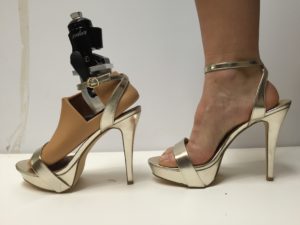A team of Johns Hopkins University students, working with a Johns Hopkins physician and outside prosthetics experts, has developed an early version of a potential solution. Called the «Prominence," it would be the first prosthetic foot on the market that is not custom made that adapts to popular fashion for heels up to four inches high.
«High heels have become an integral part of the female lifestyle in modern society, permeating through all aspects of life — professional and social," the five students who graduated earlier this month from the university’s Whiting School of Engineering wrote in their final project report. «For female veterans of the U.S. armed services with lower limb amputations, that seemingly innocuous, but so pervasive, and decidedly feminine part of their lives is gone.»
Scores of prosthetic feet are available on the market, but most are built to fit men’s shoes, and none can adjust to a heel more than two inches high. That’s less than the average women’s heel height in the United States.

With an adjustable ankle, the “Prominence” prosthetic foot accommodates even this heel, more than four inches high. [Photo courtesy of Johns Hopkins University Senior Design Team]
With some 2,100 American women who lost a leg or foot in military service, and more women entering combat assignments, the demand for a prosthesis that accommodates women’s fashion footwear is sure to grow. The students — who created the Prominence as their final senior project in mechanical engineering — hope their work can help.
The challenge was daunting: create a foot that adjusts without a separate tool to a range of heel heights, holds position without slipping, supports up to 250 pounds, weighs less than three pounds and, of course, is slender enough to accommodate a woman’s shoe.
The human foot «took thousands of years of evolution to get this way, we have one year to match it," said team member Luke Brown.
The students’ two semesters of work on the problem unfolded as a mix of mathematical calculations on paper and trial and error involving tests by machines and people. The students struggled to balance the foot’s strength and flexibility, reliability and convenience, sturdiness and lightness.
They tried a balloon in the heel to give it spring, or «energy return," as engineers say. That didn’t work. They tried a mousetrap spring, but that didn’t work, either. They tried a sideways sandwich of 23 slender titanium plates to form the foot itself, but that was too heavy and not springy. A
They built a
Using four types of women’s shoes — including a gold five-

A member of the design team tests the prosthetic prototype on a flat surface. [Photo courtesy of the Johns Hopkins University Senior Design Team]
«I had a good time walking» with it, said Capellini, majoring in public health. «It felt stable… An adjustable ankle is useful in contexts even beyond high heels. Ballet flats, sneakers, boots, and high heels especially, all vary in height, so an adjustable ankle opens up opportunities to wear a variety of shoes.»
One tester recommended a stiffer, longer toe. Another suggested moving the adjustment lever.
It’s still a work in progress. James K. Gilman, executive director of the Johns Hopkins Military & Veterans Health Institute and advisor to the group, said it will take time to assess the commercial appeal and potential of the Prominence, including the question of whether anything the team created could qualify for a patent.
«I think the final prototype produced showed the way forward," said Nathan Scott, a senior lecturer in the Whiting School’s Department of Mechanical Engineering, who advised the student group. «As usual we just need to go around the design & prototyping loop one more time.»
Source: http://releases.jhu.edu/2016/05/25/johns-hopkins-students-design-prosthetic-fit-for-high-heels/


